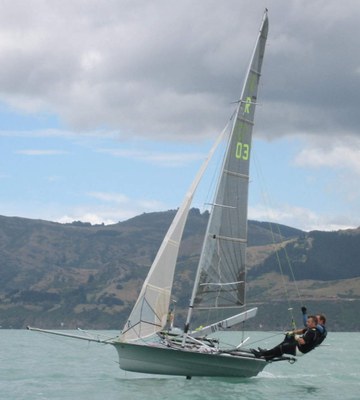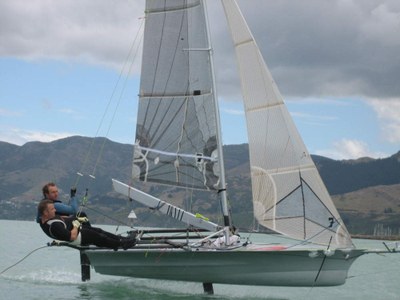Hydrofoil Project Notes - January 2009
 In the first phase of testing, our goal was simply to achieve liftoff. We experimented with a manual flap control in varying wind strengths. Sean had some trouble joining together the first set of main foil halves due to issues with the moulds, and the first version of foils had a couple of failures when the halves parted under high load. Another fault was the T joint's robustness, or lack thereof.
In the first phase of testing, our goal was simply to achieve liftoff. We experimented with a manual flap control in varying wind strengths. Sean had some trouble joining together the first set of main foil halves due to issues with the moulds, and the first version of foils had a couple of failures when the halves parted under high load. Another fault was the T joint's robustness, or lack thereof.
The join was modified and the foil repaired, but not surprisingly it failed again. Sean built a second main foil which also failed. The laminate schedule has since been revised.
Once we had the basics of foiling sorted, the next challenge was controlling the foiling height whilst maintaining sailability. A rudimentary system with an adjustable-height wand was fitted. It was routed along the gunwale and around onto the rear of the centrecase platform. This set-up was chosen mainly to avoid moving the kicker, which was connected to the base of the mast post. Although there was a fair bit of friction in the system, it worked well enough to show that the boat could foil under control, and that it was worth putting in a proper system.
With the base of the kicker moved up, the cable could be routed directly from the modified holder and clamp to the centreboard. Friction is now very low and the mechanism works well.
We've been testing the wand setting at a low height to minimise the danger of loosing control by foiling too high. We'll try varying the ride height when we've got more confidence in the mechanism and the boat's characteristics at different points of sail, wave states, and wind strength.
Some of the first test with the new wand is shown in the charteris bay clip
 It's apparent both from two-boat sailing between a foil-equipped L3 and a standard L3, and watching the videos, that even when the foiling hull is still in contact with the surface of the water, it is quicker than the standard boat. We've not been able to test in light enough conditions to determine at what stage the foils become a disadvantage.
It's apparent both from two-boat sailing between a foil-equipped L3 and a standard L3, and watching the videos, that even when the foiling hull is still in contact with the surface of the water, it is quicker than the standard boat. We've not been able to test in light enough conditions to determine at what stage the foils become a disadvantage.
In the last couple of tests the rudder stock popped off the bottom of its pivot tube. This was due to the stock distorting under load and the pin being slightly too short. This has all been rectified, and so far, nothing else has required strengthening. The rationale is still to build as light as seems reasonable and beef it up if it breaks. Fortunately, there's not been a lot of that!
When foiling, the boat is much more stable and easier to sail than a conventional R. Until now Sean and Dan have been testing without a spinnaker, mostly to keep additional clutter out of the boat. In the next test they'll likely try a small flat spinnaker as they feel that, although the boat is easy to sail upwind, they haven't yet seen the foiling R's downwind potential.
There has been plenty of outside speculation that "the boats will be harder to sail" on foils. It turns out that the R on foils is actually more stable and much easier to control. It didn't take long to acclimate to the decrease in lateral resistance from the much smaller vertical main foil, and stop falling into windward when wiring.
Now that Sean and Dan have done the hard initial work, and shown that the foils are clearly quicker, it's time to get the next keen boats up on foils. We've decided to use pre-preg for the next sets, so we have to finish setting up the vacuum table and oven before we can start. Once we have a few more foiling boats we can work on optimising set-ups.
Thanks to Sutter Schumacher for the photos and help on this article.
